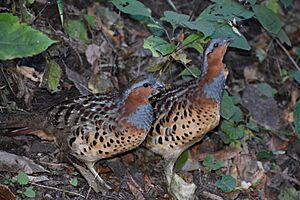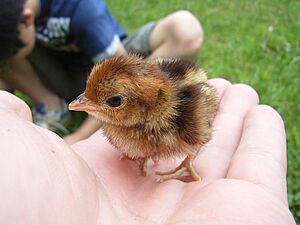Chinese bamboo partridge facts for kids
Quick facts for kids Chinese bamboo partridge |
|
|---|---|
 |
|
| Conservation status | |
| Scientific classification | |
| Genus: |
Bambusicola
|
| Species: |
thoracicus
|
| Synonyms | |
|
Bambusicola thoracica |
|
The Chinese bamboo partridge (Bambusicola thoracicus) is a small bird. It belongs to a group of birds called Galliforms, which includes chickens and turkeys. This bird is one of three types of bamboo partridges. The other two are the mountain bamboo partridge from the Himalayas and the Taiwan bamboo partridge from Taiwan. The Chinese bamboo partridge is the only type of its species.
Contents
What Does It Look Like?
The Chinese bamboo partridge is a small bird, about 31 centimeters (12 inches) long. Male birds are usually a little bigger than females. Their chest and back have a mix of black, brown, and cream colors. They also have black spots on their sides and above.
Their face and throat are a rich orange-brown color. The chest is yellowish, and there's a pale grayish-blue color above their eyes and down to their neck. These partridges have strong flight feathers, which help them fly well. Their tails are wide and square-shaped. Their wings are long and thin. These birds can fly for a long time. They often fly from the lower parts of forest trees down to the ground many times a day.
How Do They Behave?
Like many Galliform birds, Chinese bamboo partridges prefer to hide rather than fly away. But if someone gets too close, they will quickly fly off. They make loud wingbeats that can surprise anyone nearby. Inside the forest, bamboo partridges are known to fly uphill, weaving through the trees. This is a rare behavior, seen only in one other type of bird called the koklass.
Male bamboo partridges make loud calls throughout the day and all year long. These calls are like challenges to other birds. They also help birds find each other and warn about predators. Their loud contact call sounds like ki-ko-kuai or kojukei. This call is repeated many times before it slows down and stops. People hear this bird much more often than they see it. Even though it's common in its home areas, it's a shy and secretive bird.
Where Do They Live?
This bird originally comes from eastern mainland China. It has also been successfully brought to Japan, Hawaii, and Argentina. You can find it in warm forests and grasslands. Even though it's called a "bamboo" partridge, it doesn't only live in bamboo areas. The Taiwan bamboo partridge used to be thought of as a type of Chinese bamboo partridge.
Where Have They Been Introduced?
The Chinese bamboo partridge was first brought to Japan on purpose in 1919. Later, it was also brought to Hawaii, with different levels of success. In Hawaii, it's listed as an introduced bird, meaning it's not protected by the Migratory Bird Treaty Act. There's also a group of these birds living on the faraway island of Iwo Jima.
However, Chinese bamboo partridges are no longer found in Hong Kong. A program in 1961 tried to bring them back, but it didn't create a lasting group of birds there.
Keeping Them as Pets
People in China have kept Chinese bamboo partridges as pets for hundreds of years. When kept in cages, these small birds can be quite feisty. It's important to be careful about what other ground-dwelling birds are kept with them. They get along well with crestless firebacks and eared pheasants. However, they do not get along with junglefowl or francolin birds.





